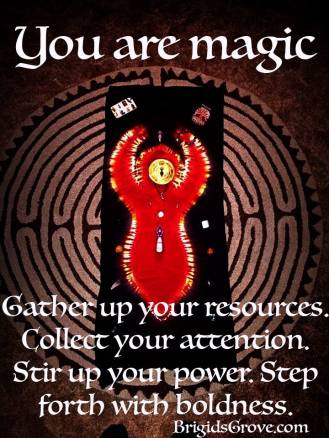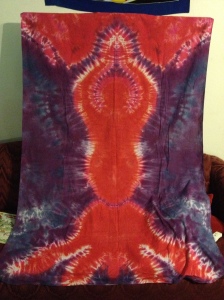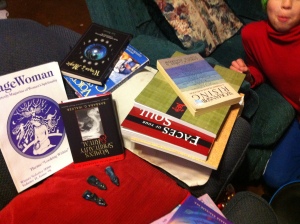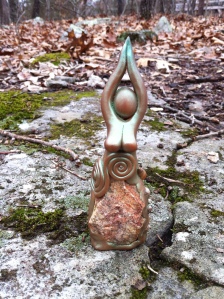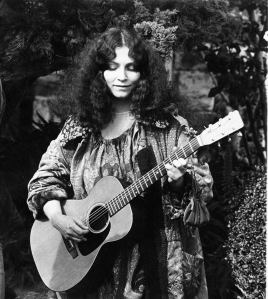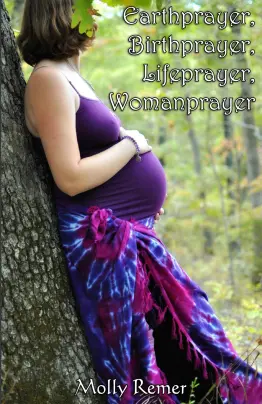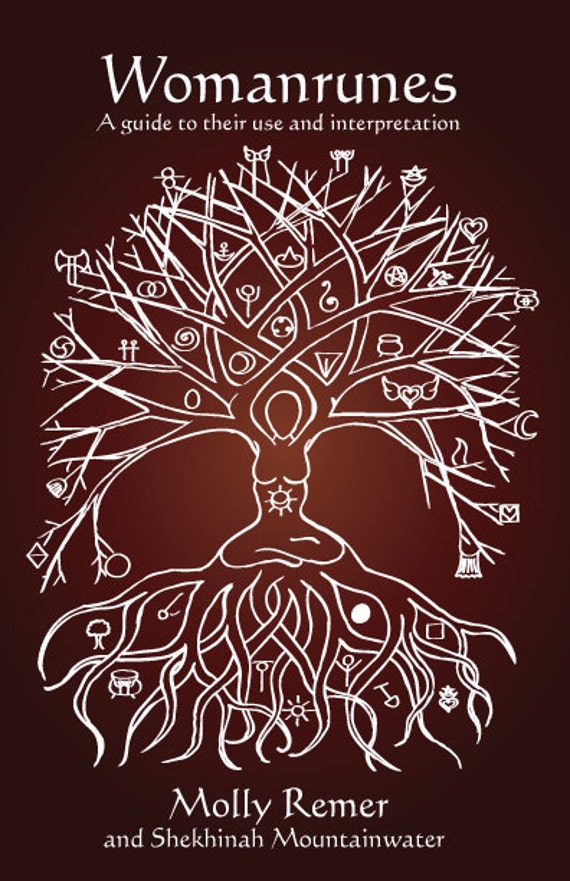While in personal experience, I have an understanding of the Goddess both as a symbol and as a metaphysical, panentheistic presence in the world, I do not find that a “real” Goddess is  required for thealogy to matter. Her importance and value as a symbol, a philosophy, and a politics are profound. As metaphor and archetype she empowers women to value themselves, their bodies, and their experiences. This is then real, whether or not the Goddess herself is real. As a sociopolitical construct, she powerfully challenges dominant philosophies about culture, society, politics, women, religion, and ecology. The Goddess as a symbol stands for a better world. A more integrated world. A world worth pursuing, preserving, and honoring. I recognize that some feminists do not feel the need for the Goddess, but I believe that feminism is richer when the Goddess is a part of it. Like it or not, religion is a part of politics in our culture. By only talking politics and ignoring religion, we leave out a powerful part of the human psyche and relationship. An embodied spirituality in which we daily walk on sacred soil and with sacred awareness can transform both politics and religion. This is why the Goddess still matters, whether as symbol or as literally existing.
required for thealogy to matter. Her importance and value as a symbol, a philosophy, and a politics are profound. As metaphor and archetype she empowers women to value themselves, their bodies, and their experiences. This is then real, whether or not the Goddess herself is real. As a sociopolitical construct, she powerfully challenges dominant philosophies about culture, society, politics, women, religion, and ecology. The Goddess as a symbol stands for a better world. A more integrated world. A world worth pursuing, preserving, and honoring. I recognize that some feminists do not feel the need for the Goddess, but I believe that feminism is richer when the Goddess is a part of it. Like it or not, religion is a part of politics in our culture. By only talking politics and ignoring religion, we leave out a powerful part of the human psyche and relationship. An embodied spirituality in which we daily walk on sacred soil and with sacred awareness can transform both politics and religion. This is why the Goddess still matters, whether as symbol or as literally existing.
The Goddess image is a profound cultural, religious, social, and political statement. She does not just personify the human feminine, she validates, celebrates, and honors the existence of the female—as normative , valuable, worthy, sacred. Thealogy must be situated in a larger feminist political context considering the role, value, and social treatment of women in order to reach its full potential. To me, thealogy must engage with matters of social justice, health care, and reproductive rights, contextualizing those issues in an ethical religious framework.
Nonrealist and Realist Conceptions of the Goddess
The political value of the Goddess as symbol and experience is touched upon by Judith Antonelli who states, “The female power is primary in nature. Woman possesses a power that no man can ever have: the capacity to give birth to new life…Patriarchy is based on the ‘phallacy’ that the male is creator. Man’s original awe and envy of woman becomes, under patriarchy, resentment and hostility. The only way man can possess female power is through woman, and so he colonizes her, suppressing her sexuality so that it serves him rather than being the source of her power” (p. 401, The Politics of Women’s Spirituality). In this conceptualization, a split occurs in which men becomes associated with the head and the mind (since men can only create with their minds/hands, not with their wombs/bodies) and women become associated exclusively with the body and with nature and devalued as below or lesser than, rather than as primary creatrix of the world. “Women today who are trying to bring back Goddess worship are not worshipping idols, escaping through mysticism, or revering an external god-substitute. The Goddess represents nothing less than female power and woman’s deification of her own essence. It is external only to the extent that this power is contained within the cycles of nature as well as within ourselves” (Antonelli, p. 403).I believe feminist spirituality can be further distinguished from a more broad “women’s spirituality” or a more specific “Goddess religion,” because of the inclusion of a sociopolitical orientation. Feminist spirituality to me is the intersection of religion and politics. It is religious feminism. It may or may not include literal experience of or perception of the Goddess, but it names the female and the female body as sacred and worthy of protection, cherishment, and defense. Despite the persistent  emphasis on reflexivity and relativism, Goddess advocates and those who identify with feminist spirituality do take an uncompromising, non-relativistic stance on violence against women and names as evil and wrong, …”the abuse and alienation of rights from women, subject men and non-human life forms by institutions sacralizing and privileging masculinity” (Melissa Raphael). Experience of the divine is personal, experience of oppression, domination, and exploitation is political and universal.
emphasis on reflexivity and relativism, Goddess advocates and those who identify with feminist spirituality do take an uncompromising, non-relativistic stance on violence against women and names as evil and wrong, …”the abuse and alienation of rights from women, subject men and non-human life forms by institutions sacralizing and privileging masculinity” (Melissa Raphael). Experience of the divine is personal, experience of oppression, domination, and exploitation is political and universal.
As Carol Christ explains, “the symbol of the Goddess has much to offer women who are struggling to be rid of the ‘powerful, pervasive, and long-lasting moods and motivations’ of devaluation of female power, denigration of the female body, distrust of female will, and denial of women’s bonds and heritage that have been engendered by patriarchal religions. As women struggle to create a new culture in which women’s power, bodies, will, and bonds are celebrated, it seems natural that Goddess would reemerge as a symbol of the newfound beauty, strength, and power of women” (quoted in Diane Stein’s anthology The Goddess Celebrates, p. 253)
I was a feminist first and a Goddess feminist much later. As Cynthia Eller observes in Living in the Lap of the Goddess, “…having become highly sensitized to any hint of sexism, it would not do to simply ignore gender; nothing would suffice but to glory in femaleness, to proclaim the spiritual potential inherent in womanhood, to take the ‘weak vessel’ of Christianity and make her the holy chalice of the great goddess. This is what these women found in feminist spirituality.” This is the essence of feminist religion to me—women are sacred, women are holy, women are wholly worthy, and we celebrate being female, including an acknowledgement and experience of the feminine divine, of the great goddess.
As Charlene Spretnak explains, “We would not have been interested in ‘Yahweh with a skirt,’ a distant, detached, domineering godhead who happened to be female. What was cosmologically wholesome and healing was the discovery of the Divine as immanent and around us. What was intriguing was the sacred link between the Goddess in her many guises and totemic animals and plants, sacred groves, and womb like caves, in the moon-rhythm blood of menses, the ecstatic dance–the experience of knowing Gaia, her voluptuous contours and fertile plains, her flowing waters that give life, her animal teachers…” (p. 5, The Politics of Women’s Spirituality)
A world that honors the Goddess, that honors feminine representations of divinity, is a world that values women, in body and in mind. Goddess spirituality transcends the limitations and boundaries placed on women’s bodies by other traditions (i.e. that women’s sexuality is fearsome/dangerous, that girls should be virginal, that bleeding is “unclean,” that older women are unattractive or have outlived their [breeding] usefulness. As Susan Griffin states, “In Goddess spirituality, women experience their bodies as sacred…” She is the whole Universe and she creates the entire world; a world in which, not incidentally, human females are of inherent value and worth.
I connect to Karen Tate’s descriptions of Goddess as “deity, archetype, and ideal.” I also like Starhawk’s description of what Goddess means to her: “It all depends on how I feel. When I feel weak, she is someone who can help and protect me. When I feel strong, she is the symbol of my own power. At other times I feel her as the natural energy in my body and the world.” While this sounds perfect to me, this fluid conceptualization of divinity is profoundly and dramatically challenging to traditional  religious structures.
religious structures.
As Esra Free notes in her book Wicca 404:
“To view the reality of the Great Goddess of Wicca for ourselves, we need look no further than our own bodies, our own planet, our own universe. Our Goddess is not some distant, invisible, disembodied spirit, nor is she ‘supernatural’ in any way, shape or form. Our Goddess is Nature, in all its manifestations. From the inconceivable whole of the vast, living universe to that universe’s tiniest constituent particle, She is physically, spiritually, energetically and personally everywhere. All the time. The Great Goddess of Wicca is All That Is, past, present and future, here on Earth, in every distant corner of the physical cosmos, and in all the seen and unseen spaces in between. There is nothing you can look to that is not Her, that is not born of Her, that does not bear the imprint of Her essence…” Free also says, “Remember that what preserves the screen door is its openness, its ability to let the storm’s fury pass through. A closed door gets blasted to smithereens. If we think of our personal, intimate, experiential relationship with the Goddess as the doorframe, as that which maintains our ‘shape’ throughout the storm, solidly framing our identity and integrity as followers of the Goddess while the flood of life passes through our ‘screen,’ what do we have to fear from other Traditions?”
And, acknowledgment of these immense forces of life actually does not require theism at all:
Thus, one can be Pagan and polytheist; Pagan and humanist; or even Pagan and atheist. Because Paganism is not a theism – it is not a statement of religious doctrine on the existence of Gods per se. It is a broadly spiritual worldview in which the cosmos is alive with powers with which we can interact. Theisms involve the recognition of those forces specifically in the form of Gods.
via Polytheism: The Light in the Window | Banshee Arts.
The existence of an ontological Goddess
To me, Goddess is found in the act of specifically naming that ineffable sense of the sacred that we all, universally, experience or perceive at some point during our lives. Whether it be in gazing at the ocean or in climbing a mountain, in the births of our children or the hatching of a baby chick, almost all humans experience transcendent moments of mystery, meaning, wonder, and awe. We can call these experiences by different names and I feel that the Goddess arises when we have the courage and capacity to name Her as such, rather than stay hazy, generic, or afraid. In my own life, I call these numinous experiences Goddess and through this I know She exists in, of, around, and through the world that I live in. It is in these experiences that I touch Her directly.
I explored this idea in one of my first posts at Feminism and Religion:
A classic, though limited, ontological argument is that God(dess) is because we can conceptualize of that existence. Rather than frame my argument for the existence of Goddess this way, I would say that Goddess is because we feel or experience that She is. Additionally, I do not actually find it necessary for a deity to necessarily meet classic theological criteria of all good and all powerful. In one of my first classes at Ocean Seminary College, I wrote the following, inspired by Carol Christ’s writing: “I have a thealogical view of the world/universe as the body of the Goddess. Everything is interconnected in a great and ever-changing dance of life. Not as ‘all one,’ but as all interconnected and relating to one another, in an ever-present ground of relationship and relatedness…I imagine the divine as omnipresent (rather than omnipotent).” The Divine is located around and through each living thing as well as the great web of incarnation that holds the whole.
As an example of this divinity that permeates each living thing, I offer a newly hatched baby chick. Bright black eyes sparkling with life, fluffy down, perfect little three-toed feet. Minutes before there was an egg, delicately posed beneath a chicken, throbbing with something, ineffable, that unfurled in a steady sequence from two cells to many, until this moment when having used its little beak, stunning in its perfection, to crack out of its shell, now peers out onto the great, grand world. This life force so evident in the transition from egg to chick also beats all of our hearts and grows all of our fingernails. This force grows the trees and makes the flowers bloom. This force is both in and around me all of the time. I am embedded in it. When I tap into that feeling of spirit within, it is making a connection or being in relationship to, that larger Spirit that makes up the world and that we all participate in and belong to, separate but connected.
via Who is She? The Existence of an Ontological Goddess By Molly Remer | Feminism and Religion.
Experience is core and belief becomes unnecessary, as in this thoughtful exploration by T. Thorn Coyle:
…To paraphrase Joseph Campbell: I don’t need belief because I have experience. I can have profoundly moving experiences of deities, or swimming in a sea of light and connection, or have a deep intuitive insight into someone else. I might come up with theories based on these experiences over time, and test these against other people’s. I can hold all of this, and still recognize that tomorrow, some new information may come along to change my mind. I can hold all of this, and know that I am holding one drop in a great ocean. I can set my skeptic aside and feel the power of my experiences of the numinous without feeling the need to build a creed around them.
We humans are storytellers. Stories apply meaning to our experiences. This is a good thing. There is truth in our stories, as well as exploration, and a connection to the line of past and future. When story becomes concretized into an unshakable belief or faith, however, humans run into trouble. We forget that the cosmos is in process. We forget that we don’t hold the whole truth, but only one facet of it…
Our stories interlock, all trying to explain the mysterious, trying to understand what is just beyond our grasp. They are always incomplete, but pointing to some reality. Until germs became proven, we needed several stories to explain the phenomenon of germs. Not being a believer offers flexibility to my experience of Mystery. Not being a believer keeps the door of possibility open.
The most succinct way I have found to explain the lack of rationality in the midst of spiritual experiences is to remind myself: “Love is not only dopamine.” I don’t need to believe in love because I experience love. Love is partially a set of chemical responses that affect my emotions, but it is also something more. Love is ineffable. So is how I feel while staring at the night sky, or my experience in the midst of ritual when I call out, and something Other shows up and I am not the only one who experiences it.
My rational brain makes sense of all this by remembering that there are many things we cannot yet explain. The glory of the cosmos is a marvelous thing that causes me to feel a sense of awe. Music transports me when the musicians are in the groove with each other, the music and the audience, and something special just appears. This “something special” is what I name The Sacred. It is holy. None of this requires belief. The numinous arrives, and something in me changes. This can happen during ritual, during prayer or at any other moment…
via T. Thorn Coyle: Why I Am Not a Believer.
In Merlin Stone’s essay about the three faces of goddess spirituality in The Politics of Women’s Spirituality she states, “So far, and let us hope in the future as well, feminists concerned with Goddess spirituality have seldom offered absolute or pat answers to theological questions. What has been happening is the experiencing, and at times the reporting, of these personal or group experiences: how it feels to regard the ultimate life force in our own image—as females; how it feels to openly embrace and to share our own contemplations and intuitive knowledge about the role of women on this planet; how it feels to gain a sense of direction, a motivating energy, a strength, a courage—somehow intuited as coming from a cosmic female energy force that fuels and refuels us in our struggle against all human oppression and planetary destruction.” To me, this makes sense—Goddess as life’s “fuel” and as an energy that surrounds and holds us all, but that does not control our behavior and does not have the ability to stop specific events from happening—events are multicausal and there are a multiplicity of forces and natural laws in the world (gravity, for example), that act in and upon the lives of humans without divine cause or intervention. She goes on to articulate a thealogical perspective that holds a lot of truth for me:
“Some say they find this force within themselves; others regard it as external. Some feel it in the ocean, the moon, a tree, the flight of a bird, or in the constant stream of coincidences (or noncoincidences) that occur in our lives. Some find access to it in the lighting of a candle, chanting, meditating—alone or with other women. From what I have so far read, heard, or experienced myself, I think it is safe to say that all women who feel they have experience Goddess spirituality in one way or another also feel that they have gained an inner strength and direction that temporarily or permanently has helped them  to deal with life. Most women interested or involved in feminist concepts of spirituality do not regard this spirituality as an end in itself but as a means of gaining and giving strength and understanding that will help us to confront the many tangible and material issues of the blatant inequities of society as we know it today.” (p. 66-67)
to deal with life. Most women interested or involved in feminist concepts of spirituality do not regard this spirituality as an end in itself but as a means of gaining and giving strength and understanding that will help us to confront the many tangible and material issues of the blatant inequities of society as we know it today.” (p. 66-67)
Finally, as Brian Swimme describes in one of my favorite theapoetical passages of all time: “From a single fireball the galaxies and stars were all woven. Out of a single molten planet the hummingbirds and pterodactyls and gray whales were all woven. What could be more obvious than this all-pervasive fact of cosmic and terrestrial weaving? Out of a single group of microorganisms, the Krebs cycle was woven, the convoluted human brain was woven, the Pali Canon was woven, all part of the radiant tapestry of being. Show us this weaving? Why, it is impossible to point to anything that does not show it, for this creative, interlacing energy envelops us entirely. Our lives in truth are nothing less than a further unfurling of this primordial ordering activity…Women are beings who know from the inside out what it is like to weave the Earth into a new human being” (p. 21, Reweaving the World).
This is creation, science, fact, come alive. This is theapoetics. The presence of the Goddess, in a way that cannot be denied.
 “Braids, tapestries, and currents in the river show us the way again and again–it cannot be one clear way or another, it has got to be both ways and together.”
“Braids, tapestries, and currents in the river show us the way again and again–it cannot be one clear way or another, it has got to be both ways and together.” rushing river: Women’s lives matter. Women’s stories matter. Women’s bodies matter. Women’s voices matter. Women’s lives and the health of the planet are inextricably intertwined. It is gorgeous and also stunning in its complexity. As I read it, I kept thinking, “how did she do this?” How did she weave so many experiences and thoughts and insights into this one text that flows so powerfully together? In The Other Side of the River, author Eila Carrico’s personal experiences and stories of her life are interwoven with descriptions, thoughts, and experiences from the world’s waters and her travels to many different bodies of water. Eila has listened to the river, learned from the waters, and these many ripples blend together into a juicy, creative, thought-provoking, complex web of questions, thoughts, and lessons. As we journey with her from the Florida marshlands to New Orleans, to San Francisco, to Africa, to India, to London, and even some time in the Mojave Desert, we also meet many water goddesses from world culture and are treated to an evocative exploration of the Goddess, the sacred feminine, at work in women’s lives and in the world as a whole. We learn from Tara and Aphrodite and Ganga and Oshun and Cailleach and Kali, all swirling together in a labyrinthine journey of depth and profundity.
rushing river: Women’s lives matter. Women’s stories matter. Women’s bodies matter. Women’s voices matter. Women’s lives and the health of the planet are inextricably intertwined. It is gorgeous and also stunning in its complexity. As I read it, I kept thinking, “how did she do this?” How did she weave so many experiences and thoughts and insights into this one text that flows so powerfully together? In The Other Side of the River, author Eila Carrico’s personal experiences and stories of her life are interwoven with descriptions, thoughts, and experiences from the world’s waters and her travels to many different bodies of water. Eila has listened to the river, learned from the waters, and these many ripples blend together into a juicy, creative, thought-provoking, complex web of questions, thoughts, and lessons. As we journey with her from the Florida marshlands to New Orleans, to San Francisco, to Africa, to India, to London, and even some time in the Mojave Desert, we also meet many water goddesses from world culture and are treated to an evocative exploration of the Goddess, the sacred feminine, at work in women’s lives and in the world as a whole. We learn from Tara and Aphrodite and Ganga and Oshun and Cailleach and Kali, all swirling together in a labyrinthine journey of depth and profundity.



